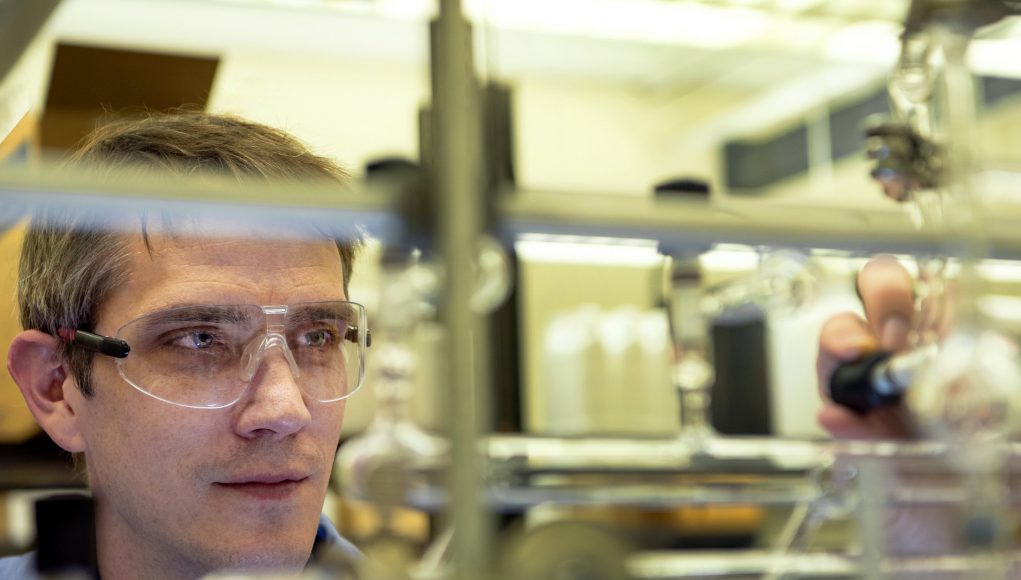A new chemical compound created by researchers at West Virginia University is lighting the way for renewable energy.
The compound is a photosensitizer, meaning it promotes chemical reactions in the presence of light. It has many potential applications for improving the efficiency of modern technologies ranging from electricity-producing solar panels to cell phones.
The study, published March 16 in Nature Chemistry, was conducted by researchers in Assistant Professor of Chemistry Carsten Milsmann’s lab with support from his National Science Foundation CAREER Award.
These technologies currently rely on precious metals, like iridium and ruthenium, to function. However, only limited supplies of these materials remain in the world, making them nonrenewable, difficult to access and expensive.
“We noticed that there have been few efforts in studying the more abundant metals titanium and zirconium because they are often not as easy to work with. Precious metals have always been the go-to elements because of their favorable chemical properties that make them easier to use and study, and that’s predominantly how it has been done in the field,” Milsmann said. “We’re hoping to change that.”
Find your dream job in the space industry. Check our Space Job Board »
Milsmann’s compound is made from zirconium, which is much more abundant and easier to access, making it a more sustainable and cost-effective option. The compound is also stable in a variety of conditions, such as air, water and changes in temperature, making it easy to work with in a variety of environments.
Since the compound can convert light into electrical energy, it could be used in the creation of more efficient solar panels.
Solar panels are typically made using silicon and require a minimum threshold of light to collect and store energy. Instead of using silicon, researchers have long been exploring the alternative of dye-sensitized devices, in which colored molecules collect light and function in low-light conditions. As an added benefit, this also allows the production of semitransparent components. To date, the necessary dyes rely heavily on the precious material ruthenium, but Milsmann’s new compound could potentially replace it in the future.
“The problem with most solar panels is that they don’t work well on cloudy days. They are pretty efficient, inexpensive and have a long lifespan, but they need intense light conditions to function efficiently,” Milsmann said. “One way around that is to make dye-sensitized versions where a colored compound absorbs light to produce electricity in any weather condition. In the future, we could design buildings that produce energy, essentially making the façade of your building, including all of its windows, into a power plant.”
On the flipside, the compound could also be used in organic light-emitting diodes, which convert electrical energy into light, essentially reversing the function of a solar panel. This characteristic makes the compund a potential light source for producing more efficient cell phone screens.
“Many cell phone displays contain iridium, another precious metal compound that does exactly what our compound does,” Milsmann said. “The advantage of having a light-emitting diode is that most of its energy is turned into light. In the past, light sources were inefficient because they only turned a small fraction of the energy they received into light.”
The research team’s next step is making the compound water soluble so it can potentially be used in biomedical applications, such as photodynamic therapy for cancer patients.
“The compound can produce reactive oxygen species that induce cell death. It sounds really dangerous, but because the reaction only occurs during exposure to radiation with light, its location and duration can be tightly controlled,” Milsmann said. “If you can focus your light onto a specific point, you can generate reactive oxygen species to act only in response to the light, making it safe. This has the potential to remove tumors less invasively than through surgeries and chemotherapy.”
Provided by: West Virginia University
More information: Yu Zhang et al. Delayed fluorescence from a zirconium(iv) photosensitizer with ligand-to-metal charge-transfer excited states. Nature Chemistry (2020). DOI: 10.1038/s41557-020-0430-7
A new chemical compound created by researchers at West Virginia University is lighting the way for renewable energy. Credit: West Virginia University











